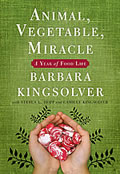
There are three food certification programs that focus on the humane treatment of farm animals. They’re all administered by animal welfare organizations. When you see these seals on meat and dairy product packaging, you know they meet certain standards of humane treatment of animals:

It’s hard to say which is best. They all have winning qualities and they all probably have some problems.
- Animal Welfare Approved (AWA) has the most stringent standards and only works with small family farms. They also don’t charge farmers, so they have no vested interest in awarding their seal.
- Certified Humane is endorsed by the ASPC. Temple Grandin is on their Scientific Committee.
- American Humane Certified (AHC) traces its roots back to the formation of the Humane Society in 1877. Temple Grandin is on their Advisory Board.
That’s all fine and good, right? Now, inevitably, the bad news: very few farmers, including those with evident concern for animal welfare, are certifying their products. In addition, the products that are being certified are difficult to find. (An upcoming post will detail Michael’s research on this, and show how to locate certified products in your area.)
We have some guesses about why so few farmers are certifying:
- Certification may be too expensive (although AWA does it for free).
- Small farmers may be selling out their entire stock without the aid of certification, reducing the incentive to certify.
- Farmers may consider one or more standards burdensome, cost-prohibitive, or misguided.
- Farmers that certify may not have the production capacity necessary to get their products into supermarkets. This may be the case with our beloved co-op.
The seals are a guarantee that a set of humane standards are met, but not having the seal doesn’t mean they’re not. For me, the seal is not needed so long as I believe the farmer is treating his or her animals humanely. What constitutes proof of this? I really don’t know. So I’ve started to go to the farmers market at Grand Army Plaza to talk to farmers directly (more on this in my next post), and soon I’ll begin visiting local farms. The journey continues.









